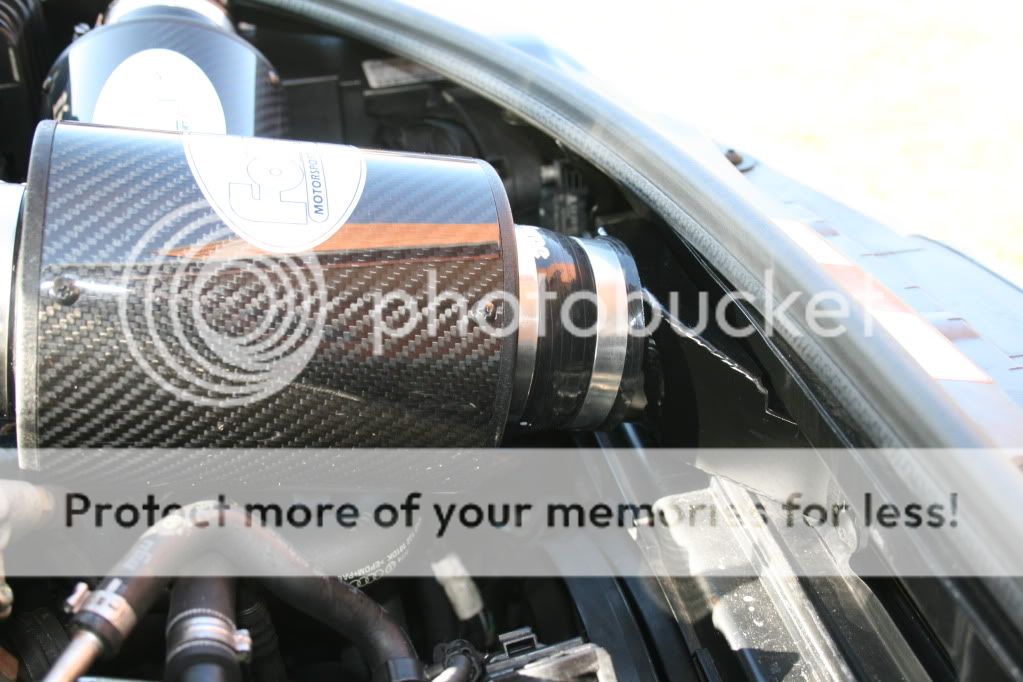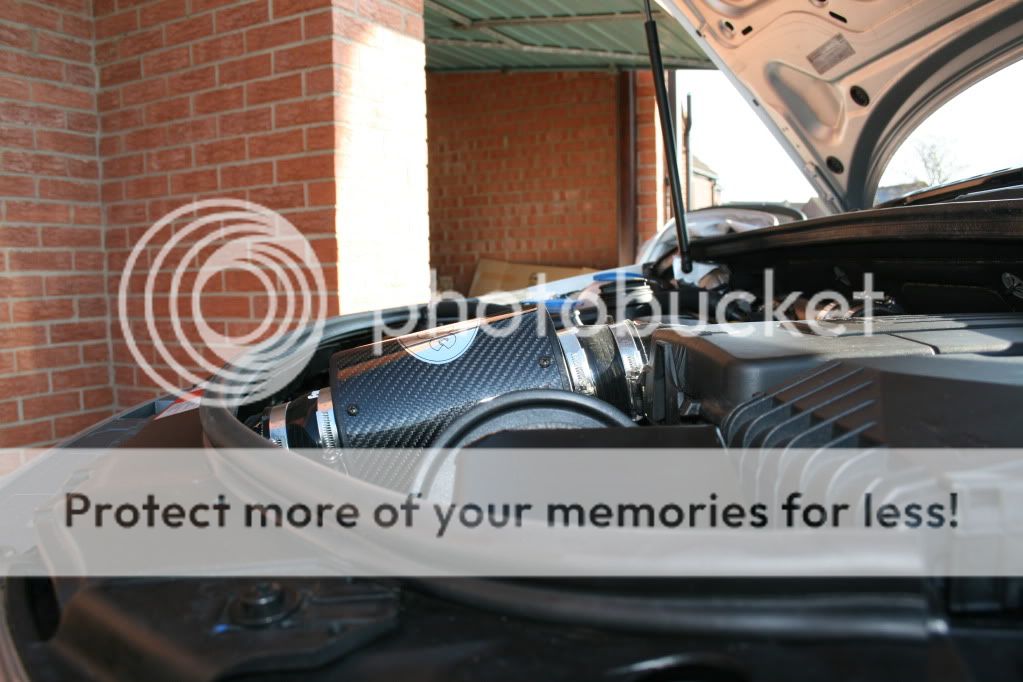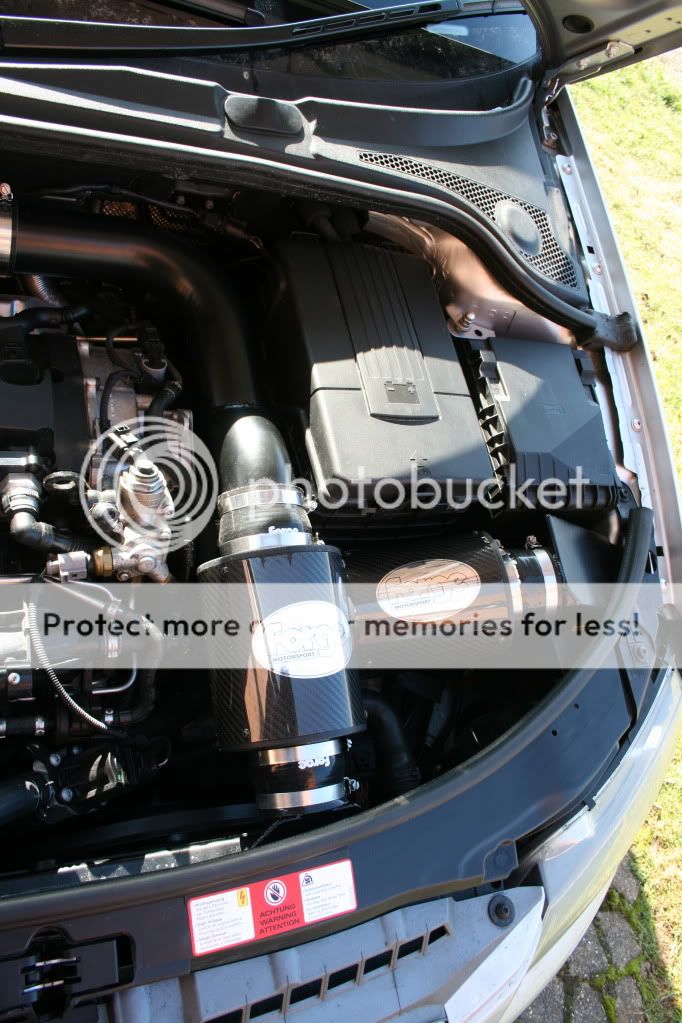Here it is:

I will post up some more pics tomorrow hopefully once the weather gets better.
Why?
The OEM intake is limited in both design and materials due to the cost prohibitive nature of making mass produced intakes that can be used for multiple platforms and engine layouts.
The OEM intake has to meet a predetermined set of requirements for the 2.0T FSI and I do not believe that efficiency and performance are necessarily at the top of that list. VAG need to consider whether or not they can use the same intake for other models with relatively minor changes to allow for mass production and cost savings. VAG are also concerned with sound volume, maintenance and appearance.
The OEM intake contains several baffles and other unnecessary obstructions to the airflow to deaden the intake sound. This helps sell new cars based on how quiet the cabin sound is but doesn't help enthusiasts like ourselves who like to hear the sounds of the turbo and have the most efficient intake possible. A tubular style intake pipe will therefore get rid of these restrictions and allow you to hear sounds of the engine and turbo working.
The OEM paper air filter is a point of restriction. Performance filters maintain or exceed the OEM's filtration ability with alot more airflow potential. Filters with good filtration but high flow are just too expensive in comparison to the OEM paper filter and are therefore not used.
There are some good features of the OEM intake which would be nice to maintain:
- It is getting air from the highest pressure zone (high pressure = high air flow) on the outside of the car, the edge of the bonnet where it meets the grill.
- It is a sealed system meaning hot engine bay air should not enter it.
- Diameter of the MAF housing as this is what the ECU is calibrated to use
- Being built into the Engine cover it helps protect the engine bay from the elements
Bearing all of the above in mind in mind I will now list the features of the Forge Twintake:
- Tubular style intake with no baffles or obstructions
- It contains two performance dry filters
- It takes air from the OEM position at the top of the grill and from the top of the grill above the passenger headlight
- It is a sealed system
- The piping has an OD of 70mm which means the ID should be so close as to not matter to 67mm so the ECUs MAF scaling should work correctly
In conclusion I believe the Forge Twintake contains all the desirable features of the OEM intake while overcoming the negatives of the OEM intake. For me the only item which is missing would be the inclusion of an engine cover and I intend to cut my orignal engine cover to fit with the Twintake.
Why two filters are better than one?
This has already been explained excellently by Robin in his Twintake review:
TBC for the S3. My car was used to develop a prototype which should lead to the full production version. I would imagine that it will be available from all the usual outlets, this link contains Forge's distributers:
http://www.forgemotorsport.co.uk/content.asp?inc=distributors
Products can be purchased directly from Forge as well
Fitting
Quite possible to fit as a DIY. For the more experienced DIYers fitting should take about 1 hour or 2-3 hours for the less experienced. I would not expect to pay more than 1 hours labour for the fitting if having it done by a garage.
I'm really impressed with the looks and quality of the Twintake. The fit and finish is superb, each time I open the bonnet it puts a big smile on my face seeing the intake and f[FONT=arial, sans-serif]or me the visual impact of the Twintake definitely has a wow factor! The Twintake mounts to existing points in the engine bay keeping things looking nice and tidy as well as being really solid.
[FONT=arial, sans-serif]Forge are taking the time to tailor the Twintake to the various VAG platforms rather than a "one solution fits all" intake. It must be a significant extra cost however I am sure it will show its benefits in quality and performance.
Other Intakes
There are many options out there:
- Carbonio
- ITG Maxogen
- EVOMS
- VF Engineering
- BSH True Seal
- Neuspeed P Flow
- Dblias
- ...
Performance
As part of the testing The Twintake was compared to the OEM intake on a dyno. Here are the results:

Compared to OEM the Twintake made an extra 26 BHP up from 298 to 323.9 and 12lb/ft Torque from 285lb/ft at 3500rpm to 297lb/ft at 4320rpm. These runs were completed back to back within an hour of each other on the same rolling road. My S3 has no other performance mods apart from a REVO Stage 1 remap. At further levels of tune ( Stage 2 and Stage 2+) I would imagine that the performance gains would be even more compared to the OEM intake. The torque is giving nice gains across the entire rev range with more area under the graph - the more area, the better the car will drive. Power does not look to be dropping off at the redline either, the car just wants to keep going! The turbo is spooling earlier with the Twintake - notice the power/torque lines are shifted up and to the left.
My car is suffering from a slight flat spot at 4400 rpm in both runs so please ignore this. It is something I will need to chase up and sort out seperately.
Driving around you can feel the performance gains. Throttle response has improved and it is at the top end where I feel the gains most. I've driven around 1000 miles with the Twintake installed now and the Long Term Fuel Trim is sitting at 4.7% indicating the MAF scaling is working nicely.
The sealed air inlets ensure that the turbo is fed with cold air. The second inlet on the S3 sits above the passenger headlight to get the air.
Forge Twintake Vs BSH True Seal:
As some of you will know previous to the Twintake I had the BSH True Seal intake on my car. This has put me in a good position to be able to compare the two intakes.
[FONT=arial, sans-serif]I do not think it is the placebo effect and the Twintake does feel stronger than the BSH. The initial delivery feels pretty similar but further along the rev range (from about 4k rpm) the Twintake feels stronger and I am sure it is producing more top end power. The sound is quieter than the BSH at WOT due to the Twintake being a sealed system. Under normal driving both intakes are quiet and you can bearly tell the difference compared to stock. Quality wise the Twintake is miles ahead of BSH and I believe it looks much better in the engine bay.[/FONT]
[FONT=arial, sans-serif]Minus Points[/FONT]
[FONT=arial, sans-serif]At the moment none for me. If you are after more sound then the Twintake may be a little quiet for some, personally I think it sounds really good.[/FONT][/FONT]
[/FONT]

I will post up some more pics tomorrow hopefully once the weather gets better.
Why?
The OEM intake is limited in both design and materials due to the cost prohibitive nature of making mass produced intakes that can be used for multiple platforms and engine layouts.
The OEM intake has to meet a predetermined set of requirements for the 2.0T FSI and I do not believe that efficiency and performance are necessarily at the top of that list. VAG need to consider whether or not they can use the same intake for other models with relatively minor changes to allow for mass production and cost savings. VAG are also concerned with sound volume, maintenance and appearance.
The OEM intake contains several baffles and other unnecessary obstructions to the airflow to deaden the intake sound. This helps sell new cars based on how quiet the cabin sound is but doesn't help enthusiasts like ourselves who like to hear the sounds of the turbo and have the most efficient intake possible. A tubular style intake pipe will therefore get rid of these restrictions and allow you to hear sounds of the engine and turbo working.
The OEM paper air filter is a point of restriction. Performance filters maintain or exceed the OEM's filtration ability with alot more airflow potential. Filters with good filtration but high flow are just too expensive in comparison to the OEM paper filter and are therefore not used.
There are some good features of the OEM intake which would be nice to maintain:
- It is getting air from the highest pressure zone (high pressure = high air flow) on the outside of the car, the edge of the bonnet where it meets the grill.
- It is a sealed system meaning hot engine bay air should not enter it.
- Diameter of the MAF housing as this is what the ECU is calibrated to use
- Being built into the Engine cover it helps protect the engine bay from the elements
Bearing all of the above in mind in mind I will now list the features of the Forge Twintake:
- Tubular style intake with no baffles or obstructions
- It contains two performance dry filters
- It takes air from the OEM position at the top of the grill and from the top of the grill above the passenger headlight
- It is a sealed system
- The piping has an OD of 70mm which means the ID should be so close as to not matter to 67mm so the ECUs MAF scaling should work correctly
In conclusion I believe the Forge Twintake contains all the desirable features of the OEM intake while overcoming the negatives of the OEM intake. For me the only item which is missing would be the inclusion of an engine cover and I intend to cut my orignal engine cover to fit with the Twintake.
Why two filters are better than one?
This has already been explained excellently by Robin in his Twintake review:
SourcingHaving twin filters is not a new idea on cars but Forge decided in early 2009 to investigate its potential for the 2.0T FSI engine (and now TSI version). As a relatively small English company with an established good reputation they would not have released it without spending an appropriate amount of time ensuring it worked flawlessly.
The main idea, though, is to create sealed inlets that allow for the introduction of the coolest ambient air possible. There are numerous debates among 'internet experts' but if the turbo system heats the air by say 50-70C before it hits the intercooler and the intercooler takes that back down by say 30-40C, then every degree colder your intake air then the lower your intake air temperatures are going to be post intercooler.
Cold air intake temp + Turbo increase temp - Intercooler reduction in temp = IA Temp in the manifold.
Apart from having the largest total possible surface area to the filtering media there are other benefits to a twin filter setup: Consider that a given filter size will present a given level of restriction to airflow, based primarily on the density of the filtering media. This will result in a given level of vacuum after the filter. Two identical filters, of the same level of restriction, applied to the same application as in this case, will apparently double the effective airflow possible by decreasing the restriction by roughly half. This will equate to more power potential.
The incorporation of a second filter doesn't introduce more airflow volume. The 70mm piping, which Forge say is the max allowable for proper MAF calibration, will only flow a finite volume of air regardless of the number of filters used. Higher flowing air filters, however, provide for a reduction in effort required to draw air through them due to a decrease in flow restriction. A larger surface area through which airflow is introduced, provides for the least possible restriction in flow.
TBC for the S3. My car was used to develop a prototype which should lead to the full production version. I would imagine that it will be available from all the usual outlets, this link contains Forge's distributers:
http://www.forgemotorsport.co.uk/content.asp?inc=distributors
Products can be purchased directly from Forge as well
Fitting
Quite possible to fit as a DIY. For the more experienced DIYers fitting should take about 1 hour or 2-3 hours for the less experienced. I would not expect to pay more than 1 hours labour for the fitting if having it done by a garage.
I'm really impressed with the looks and quality of the Twintake. The fit and finish is superb, each time I open the bonnet it puts a big smile on my face seeing the intake and f[FONT=arial, sans-serif]or me the visual impact of the Twintake definitely has a wow factor! The Twintake mounts to existing points in the engine bay keeping things looking nice and tidy as well as being really solid.
[FONT=arial, sans-serif]Forge are taking the time to tailor the Twintake to the various VAG platforms rather than a "one solution fits all" intake. It must be a significant extra cost however I am sure it will show its benefits in quality and performance.
Other Intakes
There are many options out there:
- Carbonio
- ITG Maxogen
- EVOMS
- VF Engineering
- BSH True Seal
- Neuspeed P Flow
- Dblias
- ...
Performance
As part of the testing The Twintake was compared to the OEM intake on a dyno. Here are the results:

Compared to OEM the Twintake made an extra 26 BHP up from 298 to 323.9 and 12lb/ft Torque from 285lb/ft at 3500rpm to 297lb/ft at 4320rpm. These runs were completed back to back within an hour of each other on the same rolling road. My S3 has no other performance mods apart from a REVO Stage 1 remap. At further levels of tune ( Stage 2 and Stage 2+) I would imagine that the performance gains would be even more compared to the OEM intake. The torque is giving nice gains across the entire rev range with more area under the graph - the more area, the better the car will drive. Power does not look to be dropping off at the redline either, the car just wants to keep going! The turbo is spooling earlier with the Twintake - notice the power/torque lines are shifted up and to the left.
My car is suffering from a slight flat spot at 4400 rpm in both runs so please ignore this. It is something I will need to chase up and sort out seperately.
Driving around you can feel the performance gains. Throttle response has improved and it is at the top end where I feel the gains most. I've driven around 1000 miles with the Twintake installed now and the Long Term Fuel Trim is sitting at 4.7% indicating the MAF scaling is working nicely.
The sealed air inlets ensure that the turbo is fed with cold air. The second inlet on the S3 sits above the passenger headlight to get the air.
Forge Twintake Vs BSH True Seal:
As some of you will know previous to the Twintake I had the BSH True Seal intake on my car. This has put me in a good position to be able to compare the two intakes.
[FONT=arial, sans-serif]I do not think it is the placebo effect and the Twintake does feel stronger than the BSH. The initial delivery feels pretty similar but further along the rev range (from about 4k rpm) the Twintake feels stronger and I am sure it is producing more top end power. The sound is quieter than the BSH at WOT due to the Twintake being a sealed system. Under normal driving both intakes are quiet and you can bearly tell the difference compared to stock. Quality wise the Twintake is miles ahead of BSH and I believe it looks much better in the engine bay.[/FONT]
[FONT=arial, sans-serif]Minus Points[/FONT]
[FONT=arial, sans-serif]At the moment none for me. If you are after more sound then the Twintake may be a little quiet for some, personally I think it sounds really good.[/FONT][/FONT]
[/FONT]
Last edited:

















